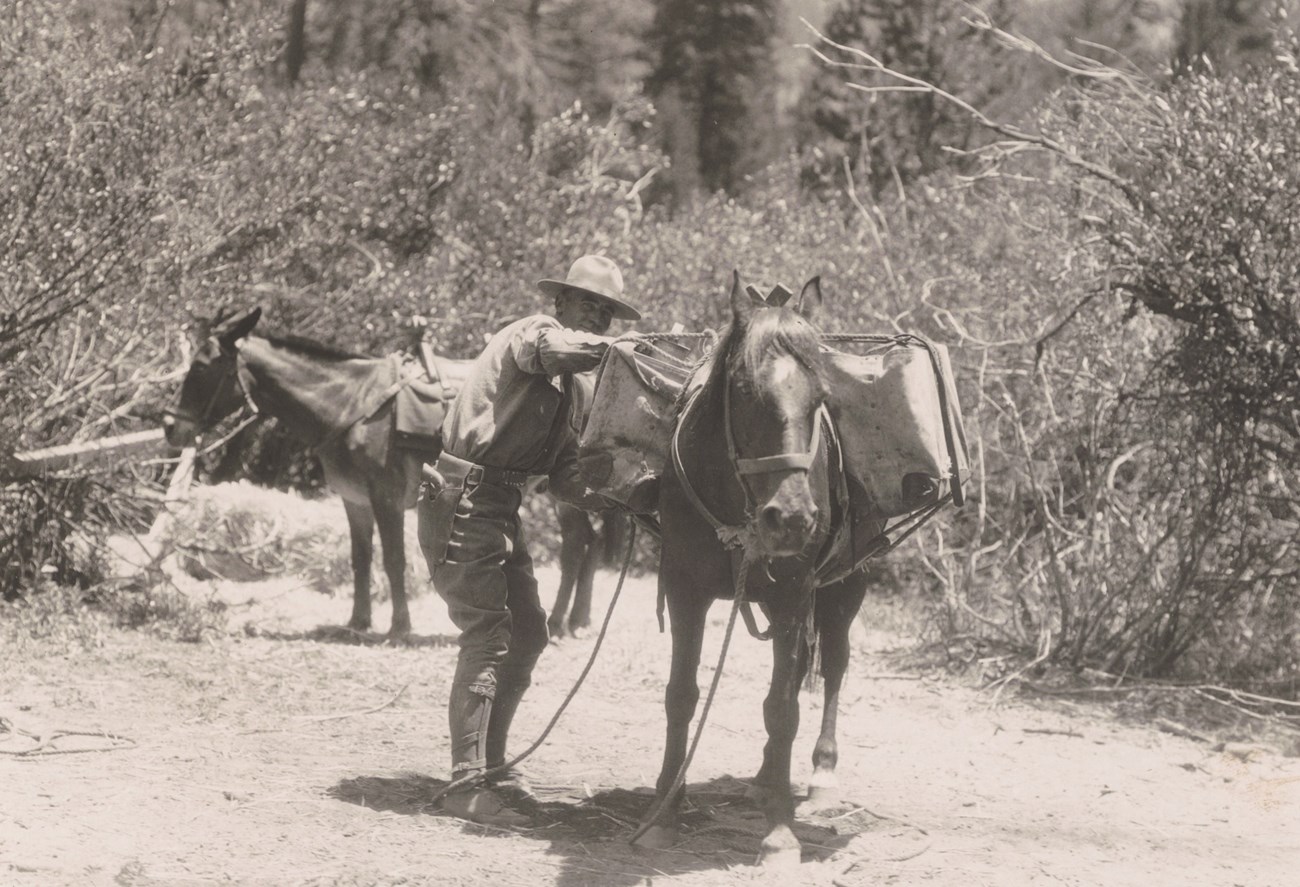Last updated: December 28, 2022
Article
50 Nifty Finds #6: Something Fishy
How do fish get up the mountain? By horse, of course! When is a plant not a plant? When you plant a fish! What? No, those aren’t nonsensical kids’ jokes. Photographs from the NPS Historic Photograph Collection will help explain.
Playgrounds of the People
The National Park Service (NPS) was established on August 25, 1916. As noted in the 1917 Director’s Annual Report to the Secretary of the Interior, NPS management had “a determination to make the national parks more popular as playgrounds of the people, where amusements can be found in addition to the scenery.”

Sportfishing was already an important pastime in some national parks. The new NPS embraced and expanded opportunities for it in an effort to increase tourism.
The 1917 annual report noted that the number of people fishing, and consequently the number of fish caught, was increasing rapidly each year. To avoid depleting park lakes and streams, the NPS expanded the fish-stocking activities that others had begun as early as the 1870s in some areas. In cooperation with the US Bureau of Fisheries, the NPS also “began the stocking of many lakes and streams not heretofore inhabited by fish.”
The practice of stocking nonnative fish in national park lakes and streams for recreation wasn’t in keeping with the mandate in the 1916 law to conserve the natural resources unimpaired for future generations. That conflict was quickly noted by biologists to no effect. The NPS continued to use “fish culture”—often to stunning degrees—for many decades.
Planting Fish
Fish planting in national parks was done with eyed eggs (where the embryo’s eyes are visible through the external membrane), fry (fish just after hatching), and fingerlings (juvenile fish about the size of a finger). Throughout national parks, milk jugs and other containers were used to transport the eggs, fry, and fingerlings on pack animals across land. Those containers could also be transported to release sites by boat. It wasn’t until the 1950s that some parks used aerial methods of delivery.


Although the history of “fish culture” in the NPS is complex and beyond the scope of this short article, the scale of NPS planting operations is worth an introduction given that these photos document how much of it was done.
Yellowstone National Park, which had its own fish hatchery as early as 1916, had the largest program. For example, in 1923—described as a record-breaking year—the park planted over 31.5 million eyed eggs, 6.2 million fry, and 150,000 fingerlings in park streams. Tens of millions more native and nonnative species were planted before Yellowstone officially ended its stocking practice in 1959.


Glacier National Park also had a large fish-planting operation, many of which they received from Yellowstone’s fish hatchery. Between 1912 and 1944, they planted almost 70.4 million eyed eggs and fry from 10 species. Millions more were planted in the late 1940s and 1950s. In 1958 the NPS and the US Bureau of Sport Fisheries and Wildlife agreed that decades of extensive fish planting “had failed to produce any notable sport fishery in the park” and that a new approach to fish management was needed.
From the first documented planting in 1877 through 1990, the last year lakes and streams were stocked at Yosemite National Park, more than 33 million fish were planted there.
Some of the other national parks that planted fish in the tens—or hundreds—of thousands from the 1910s to the 1950s include Sequoia, General Grant, Crater Lake, Rocky Mountain, Grand Canyon, Lassen Volcanic, and Grand Teton.
Fish planting continued into the 1960s even as more internal and external voices spoke out against it. In 1961, 2,169,385 fish were stocked in 14 parks. The next year the number increased to 2,497,871 even as the number of parks was reduced to 12 plus the fish hatchery at Lake Mead National Recreation Area.
Adopting the recommendations from the Leopold Report in 1969 resulted in a policy to phase out fish stocking in national parks. NPS fisheries management policies evolved, and by 1978 more emphasis was placed on species protection and eliminating nonnative species.

Sources:
Advisory Board on Wildlife Management in National Parks. (1963). The Leopold Report. Accessed 12/18/2022 at https://www.nps.gov/parkhistory/online_books/leopold/leopold.htmNational Park Service (1917). Director’s Annual Report to the Secretary of the Interior. NPS History Collection (HFCA 1645)
National Park Service (1923). Director’s Annual Report to the Secretary of the Interior. NPS History Collection (HFCA 1645)
National Park Service (1925). Director’s Annual Report to the Secretary of the Interior. NPS History Collection (HFCA 1645)
National Park Service (1926). Director’s Annual Report to the Secretary of the Interior. NPS History Collection (HFCA 1645)
National Park Service (1930). Director’s Annual Report to the Secretary of the Interior. NPS History Collection (HFCA 1645)
Olsen, Gordon C. (Undated). “Fisheries Management in the National Park Service: A Position Paper.”
Wasem, Robert. (Undated). “A Brief History of Fish Management in Glacier National Park.”Yellowstone Lake Fish Hatchery. Accessed 12/18/2022 at https://www.nps.gov/yell/learn/historyculture/lakefishhatchery.htm
Yosemite Fish. Accessed 12/18/2022 at https://www.nps.gov/yose/learn/nature/fish.htm
Tags
- crater lake national park
- glacier national park
- grand canyon national park
- grand teton national park
- lake mead national recreation area
- lassen volcanic national park
- rocky mountain national park
- sequoia & kings canyon national parks
- yellowstone national park
- yosemite national park
- fish
- fishing
- fish management
- fish stocking
- nps history
- nps history collection
- hfc
